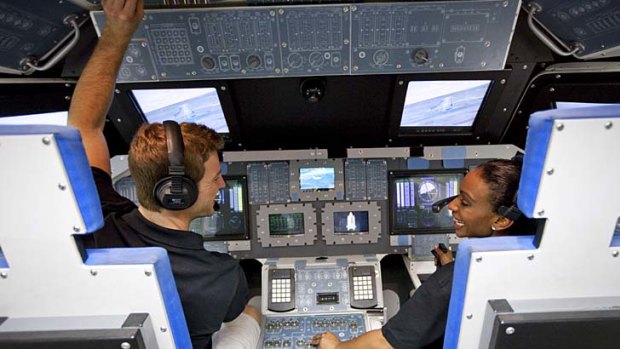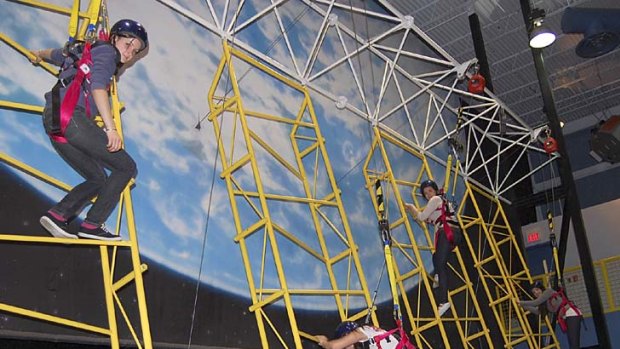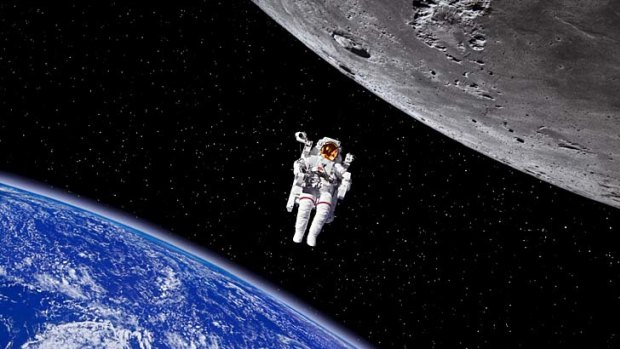This was published 12 years ago
Beam me up
With the joystick at full throttle, David Whitley plays astronaut for a day at mission central.

Switches galore ... the Kennedy Space Centre's Astronaut Training Experience.
The final space shuttle mission is not going well. Warning alarms spring into life every few minutes, the pilot is fumbling for the wrong switches and the docking manoeuvre is being controlled with the nimble dexterity of a shaky-handed alcoholic.
Alas, the astronaut wobbling that particular joystick all over the place is me. Mission control would probably sound deeply concerned at the massive deviations from course and length of time spent on a routine manoeuvre, if only they knew what they were doing themselves.
The space shuttle program was put into retirement last year but space travel fantasists are well catered for at the Kennedy Space Centre's Astronaut Training Experience. The centre, at Cape Canaveral on Florida's east coast, has been the launch site for every manned NASA mission and most of the unmanned ones as well. The sprawling multisite visitor centre includes the control room used for the Apollo missions and an unused version of the Saturn V rockets that sent man to the moon.

Floating ... the mico-gravity experience at the Kennedy Space Centre's Astronaut Training Experience.
But why learn about astronauts when you can be one? The hands-on afternoon kicks off with a rather competitive training session.
We're sat down by the simulation computers to have a go at landing the space shuttle. Precision and gentle nudges are apparently the key as the runway comes into view. It's a case of keeping the flight path diamond aligned with a target circle on the screen. Landing speed, angle of descent and position on the runway are all crucial.
The glamour job is at stake. Whoever gets closest to the perfect landing - and it's certainly not going to be the woman who ham-fistedly sent the shuttle crashing into the sea - will get to be commander on the mission.
Why learn about astronauts when you can be one?
Despite landing the beast with a surprising level of aplomb that's almost entirely absent in my driving, I'm beaten by a chap on a neighbouring computer.
"What's your name?" asks the instructor. "Houston," he replies, setting the scene for a thousand and one very obvious gags later on. They probably could have got away with doing the whole experience on the cheap, just sitting us in front of computers and saying that the various games are roughly what real astronauts train on. But when we're taken outside to the orbiter (the plane part - "shuttle" technically refers to the whole rockets and boosters shebang), it's clear that this isn't the case.
Entering through the cargo bay, we're quickly taken to the most important part of the shuttle: the loo. It's somewhat lacking in privacy, and the mechanics of going in space are an eye-opener. A combination of tubes and exceptionally good aim should see the gents right but lady astronauts face some disturbing-looking contraptions.

Space walk ... the real outer space.Credit: Getty Images
We climb up to the cockpit. It's a gulp-inducing insight into the complexity faced by shuttle commanders and pilots. Pretty much every scrap of surface space is taken up by yet another switch. Learning what they all do in every combination surely takes a lifetime of study.
I emerge with myriad silly questions, including: "How do they get the shuttles back to Florida when they land?" Answer: strapped to the back of a modified Boeing 747. And: "How are imperial versus metric measurement problems sorted when docking US vehicles to the International Space Station?" Answer: muddled compromise.
Luckily, Sam Durrance, a physicist who has spent more than 615 hours in space, is on hand. In many ways, chatting to a proper astronaut is the most rewarding part of the afternoon. Hearteningly, Durrance retains the child-like wonder that the idea of space travel instils in most of us. "We spent a lot of time at the cabin window, just looking down at earth," he says. "It's awe-inspiring."
But at the same time, he's wonderfully matter-of-fact about the extraordinarily detailed training he had to go through. He tells of how the simulators are accurate to each nut and bolt.
"You can isolate one component in 10,000 and fail it; the simulator will respond as the shuttle would and we'd have to fix it."
He spent 35 days in quarantine before and after his first flight, had to undertake cross-training in many new skills and cram himself into a one-metre diameter "transfer ball" without being told when he'd be allowed out. It's a claustrophobia test - you really don't want to discover you're claustrophobic once in space - that Durrance passed with flying colours. "I just went to sleep," he admits.
Today's motley group of trainees is lucky - we don't have to go through all the physical tests the real astronauts would face.
The special "vomit comet" plane that induces weightlessness as it lurches across the sky would be a tad expensive but the multiaxis trainer is hardly what you'd call the ideal post-lunch engagement.
I sit down, get strapped in and find myself lurching all over the place as the modern-day torture device springs into action. The whole point is that it disorients - you never know which direction it will send you spinning head over heels. It's great, whoopy fun for roughly 10 seconds and from then on it's about grim, woozy endurance.
I'm put in there for a minute - proper astronauts regularly have to sit through 15 or more.
Still, that makes me ready for the mission. With Houston in the commander's seat, the rest of us pick jobs out of a hat - something, I suspect, that doesn't feature in the NASA manuals.
I end up as one of the mission specialists - essentially, I'm in charge of attaching something to the International Space Station with a robotic arm - while the rest of the team is split between the orbiter and mission control.
We're all given scripts, although they're something of an acronym soup and the mission regularly descends into farce as "I haven't a clue which page I'm supposed to be on" comes whispering through the headphones.
But it does feel kinda real. We're counted down, we launch, I almost smash a robotic arm into the side of the International Space Station and our responses to a fire are so comically inept that we hear the howls of laughter from mission control as we burn to death.
But between the two Houstons, we manage to land safely and we emerge back on earth feeling heroic. Strike up the Aerosmith power ballad, wave the stars and stripes and release a photogenic child for us to pick up and hug on camera. The feeble have landed.
The writer was a guest of the Kennedy Space Centre.
Trip notes
Getting there
The Kennedy Space Centre is about an hour's drive west of Orlando, in central Florida. Prices for flights to Orlando via Los Angeles start about $2000 with United Airlines.
Flying there
The Astronaut Training Experience at the Kennedy Space Centre (1 866 737 5235, kennedyspacecenter.com) costs $US153.70 ($150) including tax. Bookings are essential.
Staying there
The oceanfront Inn at Cocoa Beach (4300 Ocean Beach Boulevard, 1 321 799 3460, theinnatcocoabeach.com) in nearby Cocoa Beach is a good bet. Rooms start at $US177.60 a night.
Sign up for the Traveller Deals newsletter
Get exclusive travel deals delivered straight to your inbox. Sign up now.